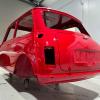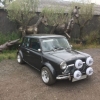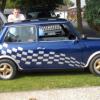
Servo Master Cylinder Replacement
#1

Posted 02 September 2020 - 06:16 PM
I've not checked in the Haynes manual yet but I'm assuming that the complete servo / master cylinder assembly needs removing before splitting ... or can it can be replaced without removing the servo.
Probably an opportunity to refurb the servo as well anyway, plus whatever horrors I find underneath!
#2

Posted 03 September 2020 - 11:06 AM
Taking the master and servo out at the same time - still attached to each other really is the way I have gone before. Think you have a couple of bolts for the bracket on the servo too, nothing complicated.
Just the 2 nuts holding on the actual master to the bracket - normally rust up - and could give you something to think about. Then there is the plastic clevis pin to disconnect for the master to servo.
A servo repair kit is around £65 and a new outright servo is £120. You will need a new servo to master seal NAM8570 (£1.50) and look at the clevis pin NAM8540 (£8.50) to see if that is worn.
If the seals in the servo are worn, a good indicator is you may blow white smoke from the exhaust, it is sucking the brake fluid in and burning it
About it really, then a full bleed, do the system good to have new fresh fluid.
#3

Posted 03 September 2020 - 02:53 PM
Brilliant information, thank you.
I wasn't originally intending to do any work on the servo itself but whilst it's out I'll give it a good check over, I suspect this will turn into a full refurbishment!
#4

Posted 03 September 2020 - 03:31 PM
The servos are pretty hardy things, as I said, a good guide is if your exhaust blows white smoke, pretty good indicator the seals need replacing in the servo
Just leaves that wretched PDWA valve on the bulkhead, non serviceable piece of junk !!!
Edited by richmondclassicsnorthwales, 03 September 2020 - 03:33 PM.
#5

Posted 03 September 2020 - 05:50 PM
As yet no white smoke.
#6

Posted 03 September 2020 - 07:06 PM
You can get the servo off and leave the brake master in place , one bolt on bulkhead , couple holding onto crossmember, remove two holding master cylinder on , remove split pin that holds the brake Clevis in place , ease master cylinder forward carefully and the servo will come off.
ignore what I wrote , should of read the post properly
Edited by hunterg30, 04 September 2020 - 09:34 PM.
#7

Posted 03 September 2020 - 08:38 PM
Id first dip the servo by removing the vacuum fitting from the front of the servo(pulls out with a pair of pliers and a strong wiggle)
Get a cable tie and go through the vacuum fitting hole to dip the lowest point of the servo... If when you pull it out its dry then just replace the Master cylinder as follows.
You do not need to remove the servo. Don't touch the servo mountings on the shell or pedal, you simply don't need to.
All you do is drain the reservoir with a syringe or siphoned very carefully not to get any in your mouth....
Gently ease the brake pipe unions loose at the FAMwtf valve on the bulkhead (just enough so the pipes can rotate) take extreme care so you don't twist the pipes, If you do they're scrap and will need replaced.
Now loosen the brake pipes at the servo end(see above about twisting).
Then you need to loosen both the nuts that hold the MC to the servo.
I'm sure the MC should now just pull off...
Refitting is the reverse of removal (top tip is to leave the brake pipe unions loose to aid bleeding)
You will now need to bleed all 4 corners of the car for safetys sake. Bleed order (assuming RHD car)
Nearside Rear (passenger rear)
Offside Rear
Nearside Front
Offside front
If you have a Haynes manual(Upto P registration) it is section 9 17 Page 9.15.
Hope this helps
Kind regards
Cal
Edited by cal844, 03 September 2020 - 09:01 PM.
#8

Posted 06 September 2020 - 12:54 PM
Unfortunately not all plain sailing .... I've bled everything in the correct order but I've struggled to get fluid to bleed out properly at the front. The n/s/f initially didn't want to let any out but a good push on the pedal (whilst using a Sealey pressure bleeder) prompted the fluid to flow nicely, but no such luck on the o/s/f, absolutely no fluid coming through.
I've got brakes now but a lot of peddle travel, as yet I haven't replaced the PDWA valve and I'm not sure exactly what the characteristics of it failing would be? Pumping the pedal has no noticeable effect.
The original problem was initially a pedal with no resistance to half way then reduced braking, later the brakes giving out to next to nothing. My understanding of the PDWA valve is that it's a brake limiter that affects the rear circuit although I must confess to not being that knowledgeable on how it works or how it would behave if it was failing or completely failed. I'm fine replacing it but I'm not sure how to tell if it's needed!
Can anyone give me any pointers from the symptoms I describe?
Edited by Bobbins, 06 September 2020 - 12:56 PM.
#9

Posted 06 September 2020 - 01:46 PM
I use the gunson presure bleeder + the myti-vac sucker systems.
But I think you'll find that there are many folk here who say the best way is the good old fashioned 2 man sytem.
Certainly worth giving that a try to 'push' the bubbles out.
#10

Posted 06 September 2020 - 02:47 PM
When I did mine I pre-bled the new cylinder by filling the reservoir with fluid and operating the plunger to get fluid through the cylinder before I fitted it. Once it was on the brakes felt absolutely fine but I did a quick bleed sequence anyway. Plenty of rags around the engine bay to catch the drips.
You could try loosening the connections on the cylinder and pump the pedal to bleed it in situ.
#11

Posted 06 September 2020 - 05:49 PM
Try adjusting the rear adjusters so the wheels are locked, then re bleed in the usual manner.
You could also try bleeding at the unions for the individual brake pipes.
#12

Posted 06 September 2020 - 07:27 PM
Thanks for all the help guys, new master cylinder now fitted. The cable tie trick to check for brake fluid in the servo works great and fortunately it was completely dry.
Unfortunately not all plain sailing .... I've bled everything in the correct order but I've struggled to get fluid to bleed out properly at the front. The n/s/f initially didn't want to let any out but a good push on the pedal (whilst using a Sealey pressure bleeder) prompted the fluid to flow nicely, but no such luck on the o/s/f, absolutely no fluid coming through.
I've got brakes now but a lot of peddle travel, as yet I haven't replaced the PDWA valve and I'm not sure exactly what the characteristics of it failing would be? Pumping the pedal has no noticeable effect.
The original problem was initially a pedal with no resistance to half way then reduced braking, later the brakes giving out to next to nothing. My understanding of the PDWA valve is that it's a brake limiter that affects the rear circuit although I must confess to not being that knowledgeable on how it works or how it would behave if it was failing or completely failed. I'm fine replacing it but I'm not sure how to tell if it's needed!
Can anyone give me any pointers from the symptoms I describe?
I had a similar problem with pedal travel and front brakes sticking, I changed the master cylinder (non-servo) bled the brakes and still had the same problem, I then changed the brake limiter valve bled the system now all is well, it did take a few goes at bleeding using an easibleed to get a full pedal again.
#13

Posted 06 September 2020 - 09:02 PM
I'll check the adjustment on the rear drums, there's nothing being improved by pumping the pedal so it could well be too much shoe travel.
Also, it's the first time I've used my Sealey pressure bleeder and I'm very impressed, definitely a massive step up on the Gunson Easybleed I had previously which I wasn't impressed with at all, this is in a different league and still not over expensive.
Attached Files
#14

Posted 06 September 2020 - 09:10 PM
Personally from experience I'd bleed the front circuit again.
Do you have the calipers on the correct sides? (bleed nipple to the top)
I have also had to bleed the air from along the pipes and FAMwtf valve by opening the unions (bleed nipples left open) and slowly pumping the pedal until fluid weeps from between the pipe and Union. Then chasing along to the caliper.
Vacuum and pressure bleeders give ineffective results on minis, they help to get the fluid flowing BUT for best results finish bleeding with the two man method.
Hope this helps
Cal
Edited by cal844, 06 September 2020 - 09:13 PM.
#15

Posted 06 September 2020 - 09:21 PM
Stu.
1 user(s) are reading this topic
0 members, 1 guests, 0 anonymous users




















